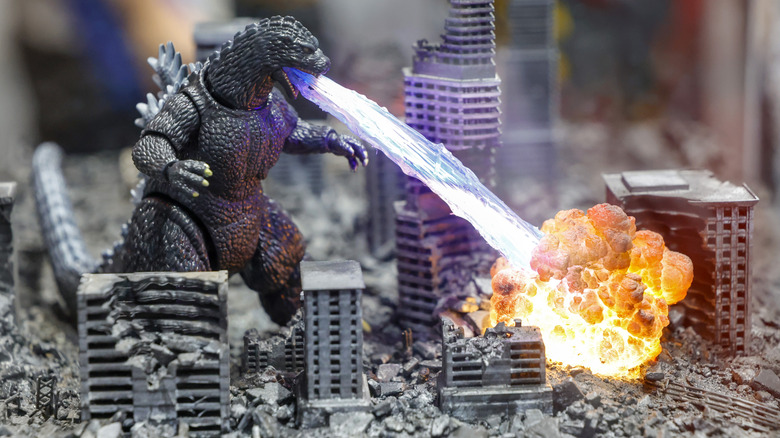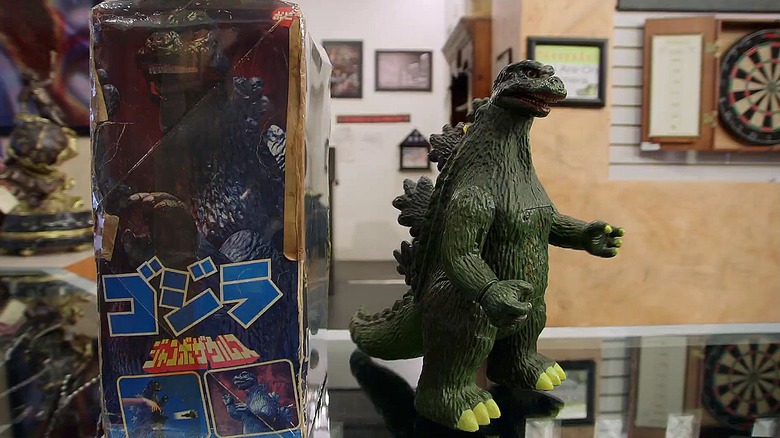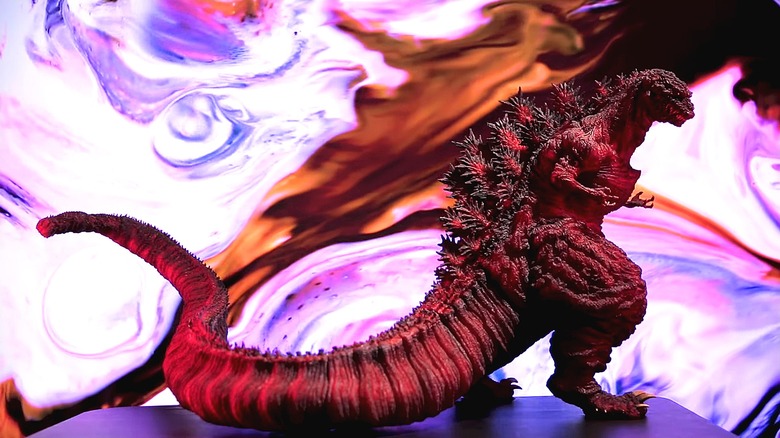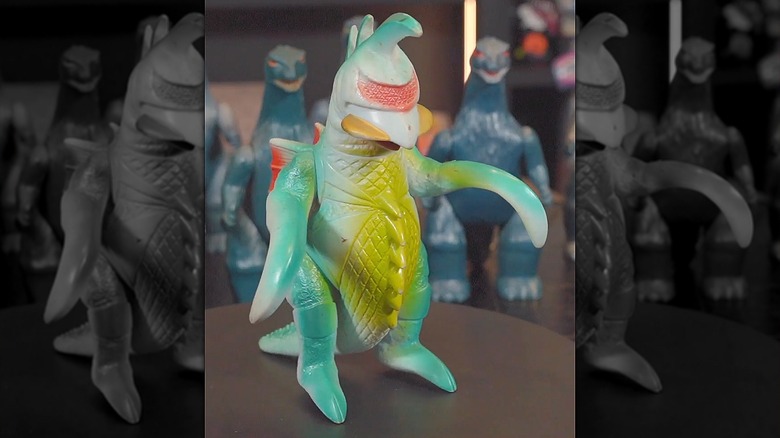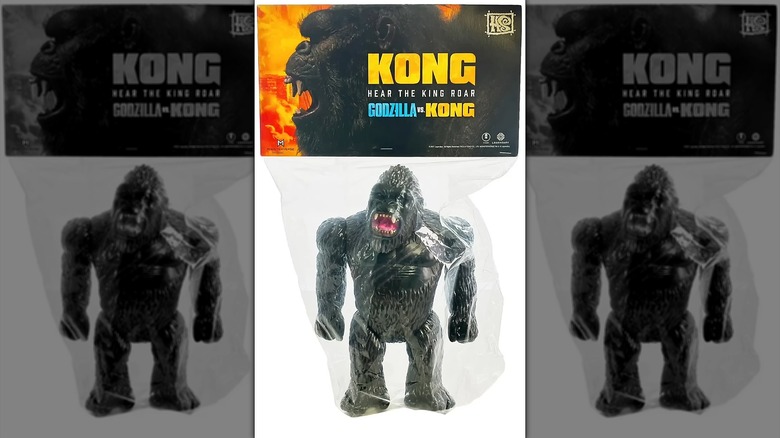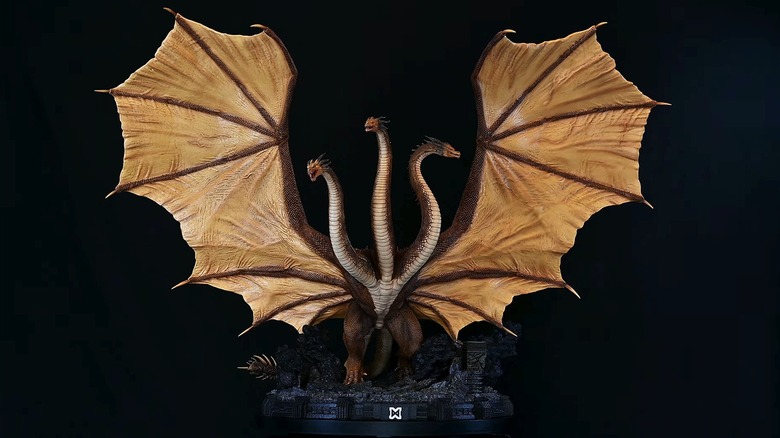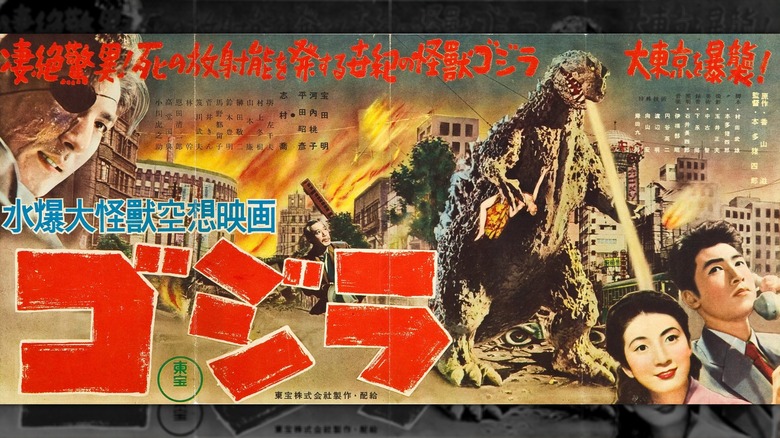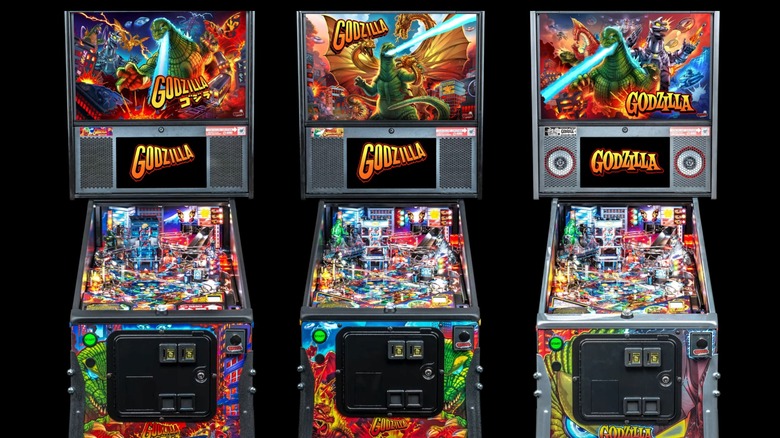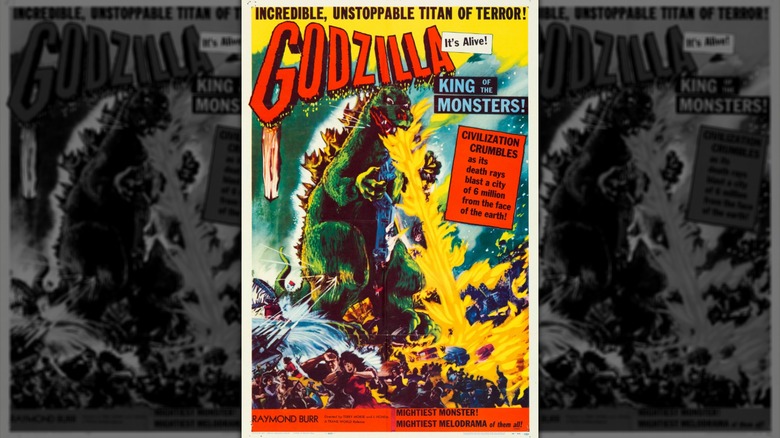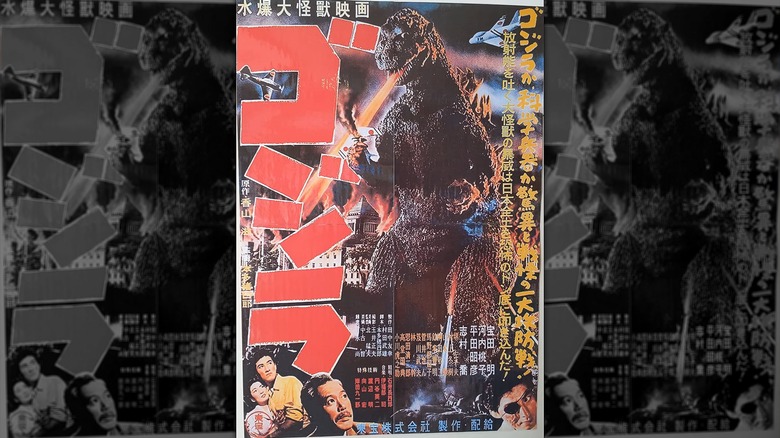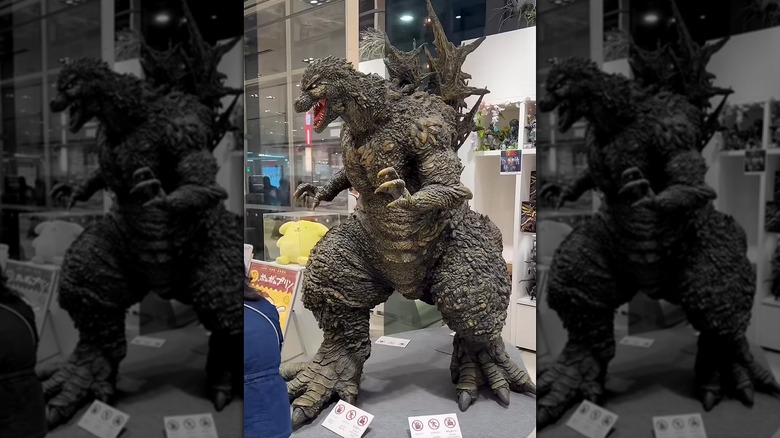Godzilla Toys And Memorabilia That Are Worth A Ton Of Money
We may receive a commission on purchases made from links.
It might be frustrating to realize the battered monster you once lobbed off the garage roof or shot with a BB gun is now worth more than your monthly rent. Godzilla memorabilia lives in that delicious spot where childhood play intersects with adult money through sofubi legends that squeak when you pull a cord or statues so vast they practically demand planning permission. Here, we're not referring to Target mass-market toys; it's a parallel economy where provenance and tiny production quirks decide whether you're holding a trinket or a trophy. Start with sofubi — the soft vinyl artistry that bloomed in post-war Japan. Pioneers like Marusan and Bullmark translated the King of the Monsters from screen to shelf, spawning variants in vivid colors and short runs that today send collectors into euphoric dives. Then, there are the limited editions of high-end resin and polystone centerpieces engineered for grown-ups with mortgages, families, and, clearly, cash to spend.
Paper isn't shy either. Early Japanese posters and press materials — never meant to last long — now fetch car-level money because they carry the radioactive glow of 1954, the year Godzilla became a legend. Pinball machine? Of course. If you can't put it behind glass, put it in a games room. Ahead, you'll tour the lots that have made seasoned collectors swallow hard. For those who know little to nothing about retro items, owning or inheriting collectibles is a curse in disguise, but the reality is that those vintage objects can, in fact, boost your net worth, giving you the chance to live your dream life. With no more to say, turn on your Geiger counter and check out these Godzilla toys and memorabilia that will certainly leave you open-mouthed.
Popy Jumbosaurus Godzilla (1978) — $1,900
Many moons ago, in 1977, Mattel produced an American toy version of Gojira called "The Shogun Warrior Godzilla." This blockbuster adaptation sprang from the Popy Jumbosaurus; let's call it the original, uncut Japanese director's edition. Both of them might seem identical from across the room, but when examined more closely, the Japanese version boasts first-rate attributes that make it far more desirable to refined collectors. Like its American cousin, the Jumbosaurus is a massive 17-inch polyethylene bruiser with wheels on its feet and a spring-punch fist; nevertheless, the head sculpt is more detailed, with a fiercer, more frightening expression –– closer to the authentic monster. Another characteristic catching the eye: Mattel's Shogun Warrior had a flicking tongue, while the Jumbo featured a grille at its center, and behind it, a talk box.
Yes, pull a string on its back, and the toy rasps a tiny, mechanical, but unmistakable roar — Godzilla's actual growl from the films. Simply spellbinding for a kid in the late 1970s. For connoisseurs today, it's a mark of authenticity that elevates the figure to another level. Adding to its mystique, the very first editions of this soft-vinyl included a "Popy" sticker on the bottom of the feet, a small detail which significantly increases its value. In the West, its rarity and the allure of superior features have transformed this toy into a treasure. For instance, recent eBay listings ask between $1,250 and $1,650 for complete examples — around the same rate as other premium old action figures. But in Pawn Stars Season 20, Corey Harrison bought a pristine example, appraised at $2,500, for $1,900. Owning a Popy Jumbosaurus says that you've gone beyond the dubbed VHS to the original Japanese import with subtitles.
X-PLUS Gigantic Shin Godzilla (2016) — $2,063
Specific figures, once cheap playthings for children, have become high-end, special-edition items for adults with mortgages, families, and office jobs. A company that targets this audience is the Japanese manufacturer X-PLUS. Its "Gigantic Series" line features enormous, breathtakingly detailed vinyl figures that are less toys and more works of art. Its take on the horrifying, ever-mutating creature from the 2016 masterpiece Shin Godzilla — the 31st film of the franchise — is a prime example of the firm's collector-focused philosophy. Standing roughly 18.5-19 inches tall, the Gigantic Series Shin Godzilla captures every grotesque detail of the film's monster, including the scarred, raw-flesh texture of its skin, its tiny and useless arms, and the nightmarish, unhinging jaw. No doubt, this release impresses us all.
But you'll find an even stronger appeal in the extremely scarce "Awakening Version," featuring a stunning purple paint scheme and an alternate split-jaw head — to replicate the moment the monster unleashes its atomic breath from its mouth and dorsal fins. Now, you might think that the previous two versions have everything. You should then see the rarer "Godzilla Store Limited Red Clear Version." Cast entirely in translucent red vinyl, it gives a terrifying, internal glow as though it were about to melt down. These massive figures were never cheap, with pre-orders starting around $455, though it's in the aftermarket where the real nuclear fire happens. The Red Clear variant has appeared on eBay with asking prices between $1,624 and $2,063. It could be a good investment opportunity — if you plan to sell it later — but you'll need to wait a while before offering it to make some money.
Bullmark Hawaiian Godzilla (1970) — $3,500
After Marusan, the creator of Godzilla sofubi, went bankrupt in 1968, a few of its employees emerged from the rubble to form a new company: Bullmark. In a shrewd move, they acquired Marusan's old molds, including the one for the iconic 1966 Godzilla, and continued producing that figure for the Japanese market. But in parallel, they created a special, limited run designed to grab the attention of American kids. The result was the legendary "Hawaiian" Godzilla, a series of figurines so vibrant and bizarre they looked like they had just walked out of a psychedelic dream. Forget the dark greens. The Hawaiian versions were cast in wild colors, such as bright blue, hot pink, and even a creamy flesh tone, then slathered with metallic gold or silver spray paint.
Because of the small production numbers and being manufactured exclusively for export, they instantly became rare and today are considered "grail" pieces by top-tier collectors. Originally sold for only a few dollars in the 1970s, an authentic Bullmark Hawaiian Godzilla is now a four-figure investment, but since this item rarely appears in public offers, it's difficult to find many auction records. Yet, based on sales of other high-end vintage Bullmark items from the era — like a boxed, battery-operated tin Godzilla that sold at auction for around $1,800 — experts in the collector's community place the value of a genuine Hawaiian vinyl in good condition anywhere from $1,500 to over $3,000. One of the few auctions recorded happened in August 2019. At the Peekaboo Gallery's "VINYLS CONFLICT: The World of Godzilla" bidding, a specimen changed hands for $3,500, along with a couple of its adversaries, Anguirus and Gigan.
Medicom / Hirota Saigansho King Kong (2021) — $6,500
In contrast to popular belief, value isn't always forged over decades of patient waiting. Once in a while, it's created overnight through a brutal combination of brand prestige, artistic collaboration, and manufactured scarcity. Take, for instance, the 2021 King Kong sofubi figure from Medicon Toy and celebrated designer Hirota Saigansho — a release to celebrate Godzilla vs. Kong. This figurine turned into an instant legend not just for its design but for how it was sold — you couldn't simply walk into a store and buy it. The only way to get one was to win a lottery. Given the hype, you might have expected a super-realistic Kong from the movie, but no; you'd see a retro-inspired art piece that evokes the chunky, charismatic kaiju toys of the 1970s, with exaggerated proportions and a hand-painted finish.
Each figure has a unique, artisanal quality. This revealed a deliberate choice to craft a piece of throwback art for a modern blockbuster. Apart from its incredible artwork, its value lies in its rarity because, according to the auction listings, only 15 of these figures were made for the lottery winners. Medicon employs this strategy for its most anticipated collaborations to ensure that demand will catastrophically outstrip supply and create an immediate, frenzied secondary market. The original cost for each of these pieces reached $600, but once it hit public offering, the price went nuclear. On January 6, 2022, a particular figure sold on eBay for a wondrous $6,500 — a clear case study in hype culture, a Fear of Missing Out generated by its impossible scarcity.
Spiral Studios King Ghidorah (Deluxe) (2020) — $8,999
Heads up: this object is not a toy. It is a monument, and a huge one. A piece of fine art that happens to be shaped like a three-headed alien dragon. The Spiral Studios King Ghidorah is the kind of piece that collections are built around — a monstrously large, incredibly detailed, and prohibitively expensive item that represents the zenith of modern kaiju collecting. Based on the Monster Zero from 2019's spectacular "Godzilla: King of the Monsters," this polystone, PVC, and resin statue stands nearly 35 inches tall, and its wingspan stretches to a jaw-dropping 53 inches — over four feet wide. And up close, you can admire its microscopic level of detail, from individual scales to the blood vessels in the wing membranes. If you're craving more, the "Deluxe Edition" takes a step further by adding a diorama base depicting a city crushed under its weight and an LED-light feature which illuminates the creature's neck, mimicking the glow of its gravity beams.
Never intended to be played with, the Deluxe Edition was limited to a minuscule 299 units worldwide, a number to guarantee its rarity and status as an instant jewel. Since Spiral Studios aimed at the most dedicated and wealthy collectors, this petrified monster's original price sat at a substantial $1,750 — only a few could even consider buying it. With the entire run selling out quickly, the secondary market has become the only way to acquire this false king. On February 18, 2023, an eBay auction for the Deluxe Edition closed at an unbelievable $8,999.99. That specific sale used stock photos. But another verified listing for a new-in-box statue currently stands at $7,500.
Gojira Press Sheet Poster (1954) — $9,500
If you want a Godzilla collectible that punches above its weight, forget the skyscraper-scale one-sheets. The 1954 Gojira press-sheet poster, from the very first movie, is a slender sliver of paper with an atomic-breath price tag. As promotional formats, press sheets were never meant to live long — handed to cinemas, pinned up, swapped out, tossed. And that potential attrition is what makes any survivor command big bucks. For instance, one crisp, 9.5" x 20" paperback example in Japanese dwells in Sotheby's vaults and is offered for a mind-blowing $9,500. In simpler terms, small sheet, kaiju-sized demand. Why the high price? Context matters. Gojira opened in Japan on November 3, 1954, a somber, steel-grey allegory about nuclear dread — less popcorn, more fallout.
Director Ishiro Honda and composer Akira Ifukube gave the world a creature that roared right out of post-war anxiety into pop-culture immortality. So, the origin story supercharges anything tied to the debut. Again, but in the Japanese language? Yes, and they are all treated with reverence. Back in 2011, another of these speed posters sold at Heritage Auctions for $2,390, but today an additional print was given a £6,000-£8,000 ($7,996.50 – $10,662) estimate at Spink, signaling where the current swells are breaking. None of this is random. Scarce format, year-one provenance, and that irresistible mix of pulp and pathos transform any 1954 Japanese Godzilla memorabilia into a champion of the food chain of kaiju paper. Having this item in your collection announces, "Gojira lives here."
Stern Godzilla Pinball (2021) — $13,900
In 2021, Stern Pinball unleashed a collectible that you can't put on a shelf or in a glass cabinet — you have to plug it in and play with it, with a gentle touch, of course. The Stern Godzilla Pinball Machine stands as a wonder of modern arcade engineering, a kinetic apparatus of light, sound, and silver balls that captures the chaos of a full-blown monster attack. The game pits players, as Godzilla, against the evil Xilien aliens and their mind-controlled army of monsters, which includes arch-enemies King Ghidorah, Gigan, and insectoid god Megalon. In terms of technology, this marvel features a motorized, collapsing skyscraper, a magnetic "Magna Grab" Newton ball — that can catch a pinball from five different parts — and a mechanized Mechagodzilla figure.
To top it all off, Blue Oyster Cult's iconic theme song "Godzilla" plays during gameplay. Stern released four versions: the Pro model, which sells for $6,999; the Premium, at $9,699; the hyper-exclusive Limited Edition (LE), valued at $13,900; and the 70th Anniversary Premium Edition, which, on Stern's site, is sold out. The LE design, the true collector's bounty, features a mirrored Mechagodzilla backglass, custom cabinet art, an upgraded audio system, and anti-reflection playfield glass. So far, the LE is one of the most expensive pieces of Godzilla merchandise, confirming that no matter the generation or century, the king of monsters still rules over the arcade.
Godzilla, KOTM! Poster (1956) — $14,400
On April 27, 1956, Gojira crossed the Pacific and reached the United States. It's the moment actor Raymond Burr, as journalist Steve Martin, stepped into the radioactive abyss while the monstrous beast breathed hellfire across a cityscape. This wasn't just another monster movie, like "The Werewolf" or "The Creature Walks Among Us", but the crowning of the King of the Monsters for Western audiences and its evolution as a global brand. To promote this future box-office hit, a one-sheet poster was released to entice the American audience into the darkened theaters to discover what Godzilla was. Since theatrical posters don't last long, clean survivors of the 1956 Godzilla — especially one-sheets and the beefier 40" x 60" — are catnip to collectors who are in love with nostalgia.
As usual, scarcity and significance accentuate this poster's value. Here are a few examples. In April 2023, Heritage Auctions sold a 40"x60" for $13,200, and a strong one-sheet fetched $10,800 the same day. Another one landed at $9,600 in October 2023. Today, owners are testing the waters at around $14,400 through Heritage's "Make Offer to Owner," which signals robust appreciation as new movies continue to be made and the franchise attracts younger fans. "Godzilla x Kong: The New Empire" (2024) was the last release, but for sure more are coming. Perhaps this is not a poster that could be worth over $200,000, but owning it warns others that your collection is a restricted zone.
Gojira Japanese B2 Poster (1954) — $25,000 - $47,500
Let's be honest. There's vintage, there's rare, and there's atomic monster rare. The 1954 Japanese B2 Gojira cinema placard stormed its way into auction history when it sold for a palm-sweating $25,000 at Heritage Auctions on July 23, 2024. But in the "Make Offer to Owner," the poster holder asks for $37,500 or more for that item. On the other sweating hand, Japan Poster has one published for $47,500 (not a typo), which would be enough to rebuild half of Tokyo — or at least buy many tiny model cities for Godzilla to stomp through. This print is not just paper but cinematic history captured in blood-red ink and mid-century menace. Released for the 1954 "Gojira," the B2 format (20.25"x28.5") was designed to market Ishiro Honda's legendary film in Japan before it exploded onto the world stage.
Scarcity, obviously, has made this poster a kaiju-sized gem. It's believed only a handful of these original posters survived, as most of them were destroyed, discarded, or eaten by time like a helpless commuter in a Godzilla rampage. The one sold in 2024 stood in "very fine+" condition, which in collector language means practically pristine, considering it dates back over 70 years old. Combine that with the eye-catching art — Godzilla mid-roar, Tokyo ablaze, and stylized Japanese text slicing through the chaos — and you literally get a holy grail for any serious monster fan. When it comes to Gojira, devotees are willing to pay king prices for the King of the Monsters. In a few years, or in a few auctions, this Gojira poster could be on the list of old movie posters with values over $100,000. Hopefully.
Godzilla Minus One Statue (2024) — $42,325
What could be more valuable than a rare kaiju toy or a poster? Without a doubt, a piece attached to the movie itself. Screen-used props are the absolute pinnacle of memorabilia collecting for ardent monster enthusiasts. For the classic Toho films, these items are virtually impossible to find; either they were lost to time or locked away in a studio archive. However, props from the 1998 American Godzilla occasionally surface, offering a tangible bond to the production. As an illustration, objects like film-used baby Godzilla egg fragments have been sold for around $300, while large pieces of the Godzilla suits and animatronics are reported to exist in private collections as witnesses of havoc. Among the most expensive prop-related items is a Megahouse 1964 Hand Puppet, listed on eBay for $5,000. But even a screen-worn relic pales in comparison to the ultimate tribute.
In November 2024, Toho announced the release of a human-scale, full-size statue based on the monster's appearance in Godzilla Minus One (premiered in 2023). Standing an incredible 7 feet, 6.5 inches tall (2.3 meters), this effigy is not only a collectible but also a colossal monument. And its rarity was engineered to be absolute — only three units were made and sold exclusively through Amazon Japan. The price for this bit of kaiju history? A wallet-trembling $42,325 — a sum that anchors its status as a piece of memorabilia and, thus far, one of the most expensive and exclusive Godzilla items ever created. Undoubtedly, this sculpture is pricier than many Star Wars collectibles. To assemble this Godzilla, you've got to rebuild your house — it can't fit in an apartment — or buy a new home just for the statue. Please don't put it in the front yard.
